Salcido A. (ed.) Cellular Automata - Simplicity Behind Complexity
Подождите немного. Документ загружается.

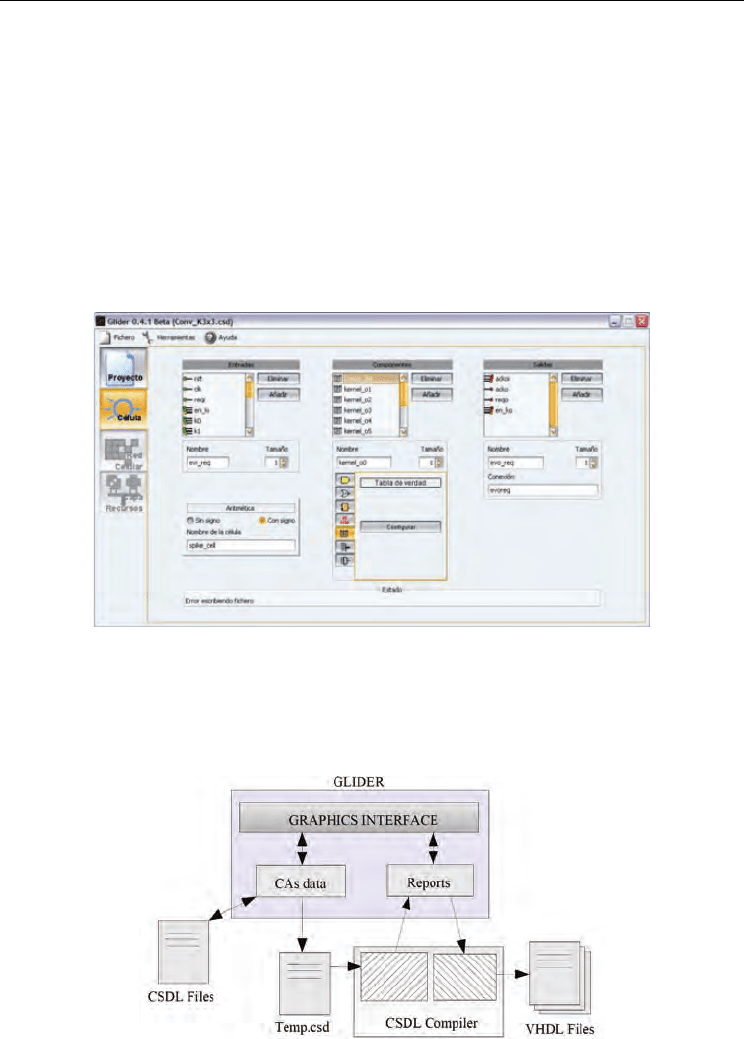
Visual Spike Processing based on Cellular Automaton
537
There are three main descriptions that define Cellular Automaton: cells, cellular network
and resource layer. Figure 8 shows the Glider interface for the description of a Cellular
Automaton.
Cell: The cell definition consists of defining the set of inputs and outputs, that could come
from or go to other cells or could be common for all cells; and defining the operations that
cell has to implement with the inputs to generate the outputs. As the cellular automaton
depends on the time for the state definition, both sequential and combinatorial logic must be
used for a cell. A Cellular Automaton could be formed by several cell definitions.
Cellular Network: The connectivity of cells, the morphology of the network and type of cells
used are the parameters that define the Cellular Network.
Resource Layer: This layer defines how a cellular network is connected to another cellular
network. It also defines the global inputs and outputs, and the initialization of cells.
Fig. 8. Snapshot of Glider Java application
Figure 9 shows a block diagram of the Glider internal operation. The graphics interface
generates the CSDL files of the Cellular Automaton definition. The CSDL compiler is
invoked automatically from this Java application and VHDL files are generated. The console
messages are redirected to the application.
Fig. 9. Internal block diagram of Glider Java application

Cellular Automata - Simplicity Behind Complexity
538
An interesting capability of Glider is that it keeps continuously checking the consistency of
the CSDL generated from the graphics developed by the user. The error or warning
messages are reported to the user automatically and in real time.
6. Testing scenario
In order to test this prototype the USB-AER board will be used. This card was developed by
the department of Computer Architecture and Technology of the University of Seville for
the development of AER devices and it is based on a FPGA Spartan-II 200 of Xilinx.
6.1 AER tools for hardware implementation of an AER-CA
The USB-AER board includes two AER ports (Gomez-Rodriguez et al., 2006), an input AER
bus and an output AER bus, connected directly to the FPGA that allows implementing any
hardware for manipulating or processing AER information. The Spartan-II 200 FPGA that
can be loaded from MMC/SD or USB through the C8051F320 micro-controller. It also
contains a large SRAM bank (512Kx32 12ns).
AER IN PORT
IN
Buffer
FPGA
OUT
Buffer
AER OUT PORT
RAM
Bank 0
512k
RAM
Bank 1
512k
RAM
Bank 2
512k
RAM
Bank 3
512k
C8051F320
Microcontroller
USB
MMC/SD
AER IN AER OUT
Data
Micro Data Micro Control
Req In
Ack In
Req Out
Ack Out
Req Out
Ack Out
Req In
Ack In
Address
WR4
WR3
WR2
WR1
Fig. 10a. USB-AER Board block diagram
The USB-AER functionality depends on the module that is loaded in the FPGA. For
example, it may act as a sequencer, monitor, mapping, event processor, data-logger, etc.
Most of such functionalities may be performed in a standalone manner. This standalone
operating mode requires loading the FPGA and RAM banks from some type of non-volatile
storage, e.g. MMC/SD cards. USB input is also provided for development stages.
6.2 Testing AER-CA
Three USB-AER boards have been connected in line, as figure 10b shows, in order to test
and measure the performance of these processors. Sequencer firmware is loaded in the first
board to send a stream of events which depends on the image previously loaded. The
convolution processor under test is loaded in the second USB-AER board. This board
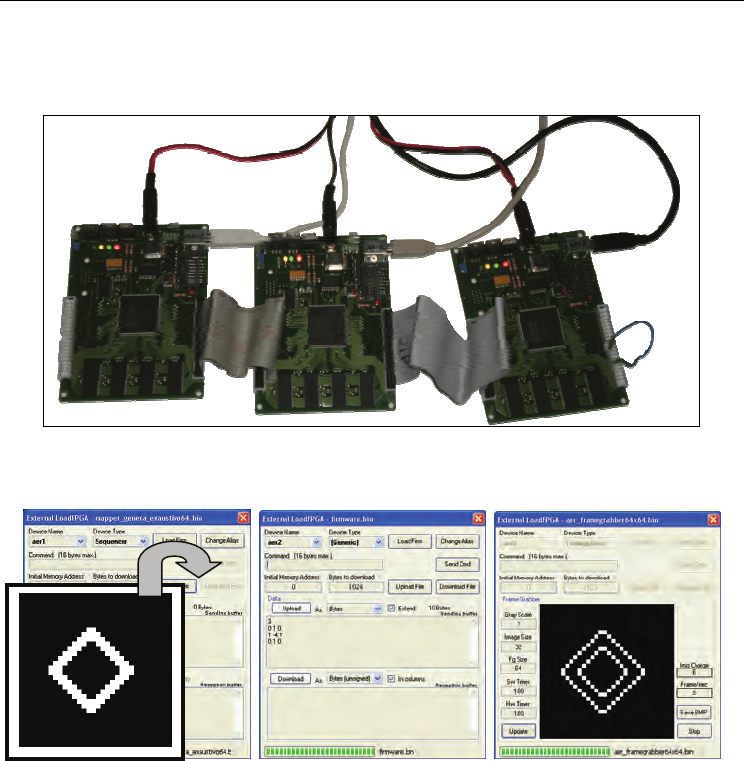
Visual Spike Processing based on Cellular Automaton
539
receives spikes from the sequencer and carries out the filtering operation according to 3x3
configurable kernel loaded. The third USB-AER board is loaded with a data-logger firmware
to store, in real-time, the time-stamped address of the convolution output events.
Fig. 10b. USB-AER boards for testing AER-CAs.
Fig. 11. Snapshot of MultiloadFPGA application
A Windows XP application called MultiloadFPGA (figure 11) controls and configures every
USB-AER via USB. Captured spikes can be processed off-line by MATLAB to test the
processor and measure performance.
6.3 Performance
The implementation developed requires three clock cycles for every event received: a
synchronization cycle, a cycle for edge detection and another one to calculate cell states.
Furthermore, this version requires two cycles for every new event generated: one cycle to
send an event and another one to wait for the acknowledgement. This implementation
yields up to 16.6 mega-events per second when no event is generated. In addition, nine
ADD operations are computed every three cycles, thus the system yields up to 150 MOPS
when a 50 MHz clock is used.
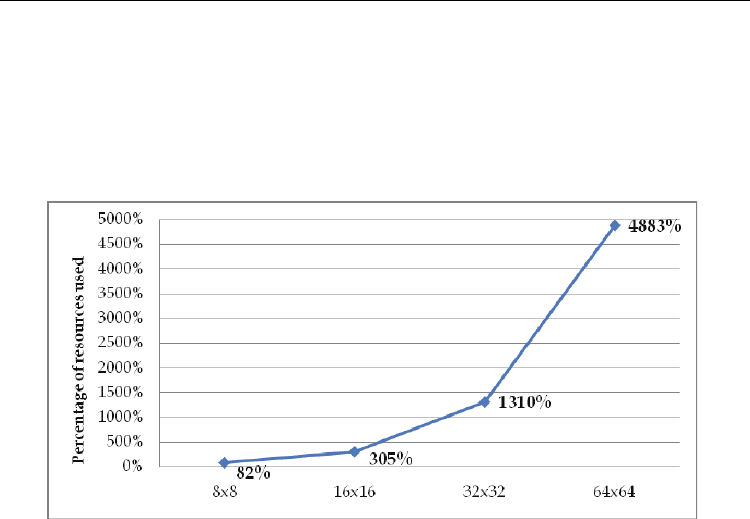
Cellular Automata - Simplicity Behind Complexity
540
The event rate achieved is determined not only by convolution processor delay but also by
input and output event rate. The input event rate depends on the image loaded into the
sequencer and the output event rate is related to the kernel coefficients and threshold.
Figure 12 shows the percentage of the resources used in the Spartan-II 200 of the USB-AER
board for different net sizes. Each cell records its state in a 8 bit registry and the kernel
coefficients are 4 bit.
Fig. 12. Percentage of used resources respect to Spartan-II 200
An 8x8 grid spends 84% of all resources in a Spartan-II 200 and it is the largest grid that may
be loaded. The resources needed for the AER-CA grow fast with the increase of the net size,
e.g. a 32x32 grid requires a FPGA thirteen times larger. This growth is due to the
requirement for individual resources of every cell implemented.
7. Resource optimization
The previous implementation requires many resources, so a new implementation is
proposed that optimizes resources.
7.1 AER-CA in memory
This new implementation exploits a quirk of the AER-CA: when an input spike arrives, only
a subset of cells work simultaneously, the targeted cell and its neighbors. So, it may be
possible to maintain the state of every cell in memory and to implement only a shared
subset of cells (computational units) that perform the operations needed when a new spike
arrives. This new implementation requires less logic but uses memory banks to save the cell
states.
Each one of the implemented cells always works with the same kernel coefficient and a
different cell but it is the same neighbor regarding to the target cell. Additionally, cell states
are strategically distributed to several memory banks so that each implemented cell accesses
to a different RAM bank simultaneously.
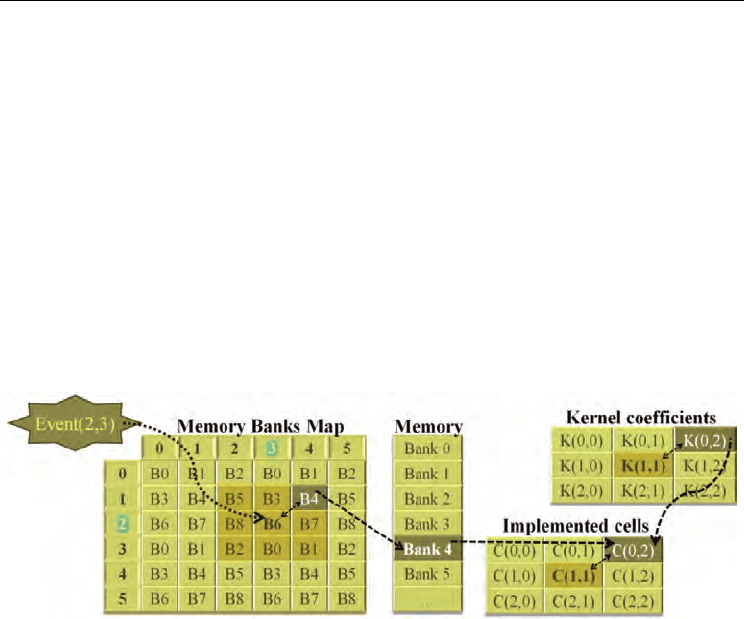
Visual Spike Processing based on Cellular Automaton
541
An example for a 3x3 Kernel and 5x5 grid size is illustrated in figure 13. Each location in the
grid indentifies a cell and it is labeled by Bx where x is the number of bank associated to that
cell. When the event (2, 3) arrives, the implemented cell (1, 1) uses kernel element K(1,1) and
bank B6 to modify the state of cell C(3, 2), the implemented cell C(0,2) uses K(0,2) and B4 to
modify the state of neighbor (1,4), and so on until eight neighbors, but each implemented
cell accesses to a different bank.
The memory address and memory bank that every implemented cell uses is a function of
the corresponding row and column cell. When row and column are divided by 3, quotient
corresponds to memory addresses and remainder indicates memory banks, e.g. when the
event (2, 3) arrives, neighbor (1, 4) uses B(1 mod 3 , 4 mod 3 ) = B(1,1) that belongs to B4
(because B(0,0) = B0, B(0,1) = B1, B(0,2) = B2, B(1,0)= B3, B(1,1) = B4, etc).
Fig. 13. Example of 3x3 Kernel AER-CA with cell states in memory
7.2 Implementing AER-CA in memory
As it would happen in the first version, the development of element nets in VHDL may be
difficult, especially if we want to make several designs with different net sizes, kernel, etc.
This is why an application in C# that generates the AER-CA automatically from the desired
parameters has been designed. Besides, this application allows to synthesize the VHDL code
generated for the FPGA wanted. Figure 14 shows a picture of the application running.
3 areas can be differentiated within this application. The control zone is located at the upper
section and it is used to set the design wanted and to initiate the generation and synthesis
process. The design parameters that will be used to set the development board are net size,
convolution kernel size and the number of bits used to store the state of each cell. The
bottom section shows a state window to report the evolution of the process. The left-mid
section shows the tree of files generated and the state of the synthesis process. The right
section shows the code of the selected file in the file tree. This application also allows to
choose the AER-CA implementation desired to be generated, the original version or the
memory-based one.
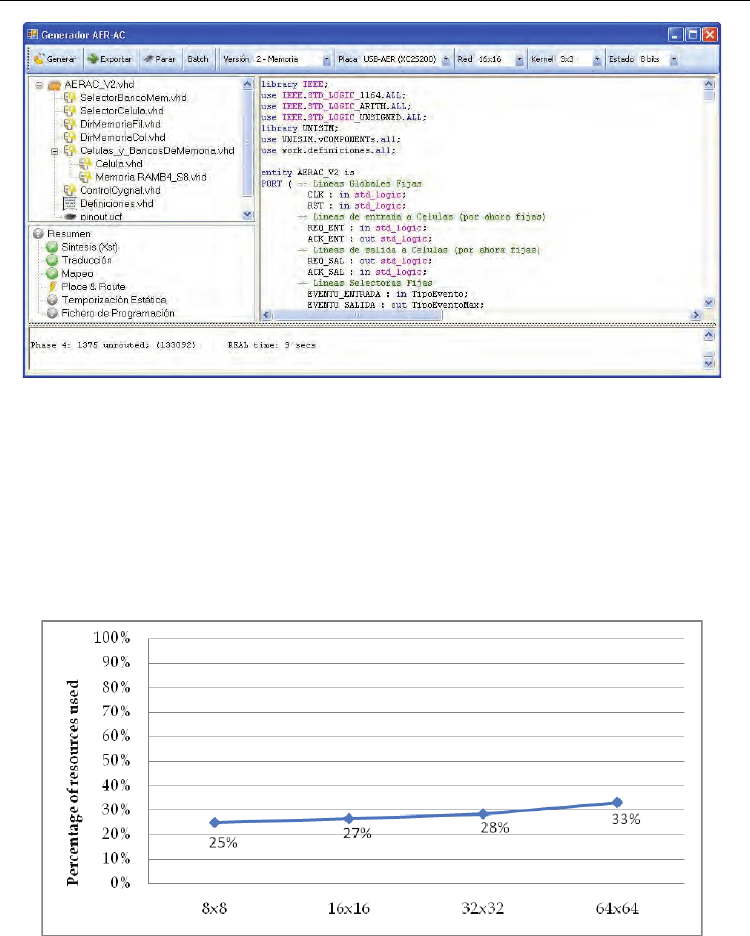
Cellular Automata - Simplicity Behind Complexity
542
Fig. 14. Snapshot of AER generator application
7.3 Performance
This new implementation saves many resources in comparison to the former one. The
diagram in figure 15 shows the percentage of the internal logic of the Spartan-II 200 needed
to implement this new version for different sizes of kernel. For greater net sizes the
percentage of usage of the Spartan-II 200 increases very slowly. This is because the number
of implemented cells does not vary with the size of the net, unlike what occurred in the first
version. The number of cells implemented is determined by the size of the kernel.
Fig. 15. Percentage of used resources for improved version respect to Spartan-II 200.
In this version, the memory of the FPGA is the one that determines the size of the net since
the state of cells is stored in memory. The Spartan-II has 7 Kbytes distributed in 14 memory
banks of 512 Bytes. An AER-CA with 3x3 kernel uses 3x3=9 from the 14 memory banks. The
biggest net that can be obtained from an AER-CA with 3x3 kernel in a Spartan-II is 64x64

Visual Spike Processing based on Cellular Automaton
543
and it uses 4 Kbytes of the 7 Kbytes that the Spartan-II has. AER-CA with Kernel greater
than 3x3 requires FPGA with a greater number of banks.
This new implementation requires six clock cycles per received event. Unlike the previous
version, this implementation takes four cycles to calculate cell states: A cycle to calculate
memory addresses and banks, a cycle to connect each unit to the appropriate bank, another
one to read the current state and the last one to write the new state in memory. As the
former implementation, this version also requires two cycles per event. It performs up to 8.3
mega-events per second and 75 MOPS.
7.4 Future improvements. A probabilistic AER-CA
Both presented versions require storing the state of every cell. A probabilistic version may
be developed to avoid storing states, i.e. a random number and the corresponding
probability determine when cells fire instead of adding kernel coefficients until threshold is
achieved. This new version may increase processing speed and may be able to work with
larger grids in the Spartan-II 200.
8. Conclusion
Cellular Automaton approach has been proposed to develop AER neuro-inspired filters for
vision processing. These filters can implement two layers, one for the input processing and
the second one thanks to the evolution rule.
AER filters based on 3x3 kernel convolutions have been implemented in VHDL using
Cellular Automaton approach.
Two 3x3 kernel convolution AER processor for vision processing inspired in Cellular
Automaton have been implemented for FPGA. The original implementation assigns
resources to each cell. It performs up to 150 MOPS for a 3x3 kernel and yields up to 16.6
Mega-event per second in a Spartan-II 200. An improved version, that stores the cell states in
memory to save resources by reducing number of implemented cells, has also been
implemented. This second version achieves up to 75 MOPS and 8.3 Mega-event/s.
A real scenario consisting of three USB-AER tools has been used to prove these
implementations and to carry out a performance analysis.
A probabilistic version is suggested to increase processing speed and to reduce resources.
9. References
Boahen, K.A. (1998). Communicating Neuronal Ensembles between Neuromorphic Chips.
Neuromorphic Systems. Kluwer Academic Publishers, Boston 1998.
Cerdá, J.; Gadea, R.; Herrero, V.; Sebastià, A. (2003). On the Implementation of a Margolus
Neighborhood Cellular Autómata on FPGA. Field-Programmable Logic and
Applications. Lecture Notes in ComputerScience 2778, pp. 76-785.
Cerdá, J. (2004). Arquitecturas VLSI de autómatas celulares para modelado físico (in
Spanish). PhD Thesis. Universidad Politécnica de Valencia, Valencia, Spain, 2004.
Farabet, C.; Poulet, C.; Han, J.Y.; LeCun, Y. (2009). CNP: An FPGA-based Processor for
Convolutional Networks. International Conference on Field Programmable Logic
and Applications, 2009. FPL 2009.

Cellular Automata - Simplicity Behind Complexity
544
Gomez-Rodriguez, F.; Paz, R.; Linares-Barranco, A.; Rivas, M.; Miró, L.; Jimenez, G.; Civit,
A. (2006). AER tools for Communications and Debugging. Proceedings of the IEEE
ISCAS 2006, Kos, Greece. May 2006.
Lichtsteiner, P.; Posch, C.; Delbruck, T (2008). A 128×128 120 dB 15 μs Latency
Asynchronous Temporal Contrast Vision Sensor. IEEE Journal of Solid-State
Circuits, IEEE Journal, Vol 43, Issue 2, pp. 566-576, Feb. 2008.
Mahowald, M. (1992). VLSI Analogs of Neuronal Visual Processing: A Synthesis of Form
and Function. Ph.D. Thesis. California Institute of Technology, Pasadena, California
1992.

1. Introduction
Cellular automata are a powerful concept for the simulation of complex systems; they have
successfully been applied to a wide range of simulation problems Boccara et al. (1993);
Canyurt & Hajela (2005); D’Ambrosio et al. (2007); Ermentrout & Edelstein-Keshet (1993);
Georgoudas et al. (2007); Guisado et al. (2006); Nagel & Schreckenberg (1992); Popovici &
Popovici (2002); Stevens et al. (2007). This work is typically done by scientists who are
experts in their field, but generally not experts in programming and computer architecture.
Programming complex simulations both correctly and efficiently quickly turns into a painful
implementation venture distracting from the far more interesting aspects of the simulation
problem itself or the simulated subject matter.
Current advances in computer architecture make the situation even worse. Abundance of
parallel processing power through multicore technology requires parallelisation of simulation
software in order to effectively use even standard laptop and desktop computing machinery,
not to mention clusters of workstations and fully-fledged supercomputing equipment.
This situation confronts our dear simulation scientist not only with the task of writing
a fairly efficient sequential program, but exposes him or her to the notorious hazards of
parallel programming Amarasinghe (2008); Chapman (2007); Gabb et al. (2009). Getting
synchronisation and communication requirements correct and deterministic is know to be
a far from trivial task, but in fact the problem is even more intricate. Today’s hardware
reality quickly creates a multi-level granularity problem with different communication and
synchronisation abstractions and very different latency/throughput characteristics on each
level, from networks interconnecting geographically separated compute centers to multiple
cores within the same processor. An experienced programmer can certainly solve all these
issues with sufficient time and resources, but the point we make is that scientist we have in
mind should not devote his time to this, but rather work on improving his or her model, etc.
The model of cellular automata naturally lends itself to parallel execution following a data
parallel approach. This holds not only for multicore processors on the desktop, but likewise
for clusters of workstations and parallel computers, in other words on all levels of today’s
multi-level compute environments. Yet surprisingly little support for programming cellular
automata with a focus on high-performace simulation exists. Simulation software is typically
Clemens Grelck
1
and Frank Penczek
2
1
University of Amsterdam
2
University of Hertfordshire
1
The Netherlands
2
United Kingdom
Design and Implementation of CAOS:
An Implicitly Parallel Language for
the High-Performance Simulation
of Cellular Automata
25

limited in the complexity of cellular automata that can be described: the number of states per
cell and the state transition function are typically more oriented towards demonstrations of
Conway’s game of life Conway (1970) than towards real-life simulations. Furthermore, many
approaches seem to focus on the visual aspects of cellular automata rather than simulation
performance. Programming complex cellular automata in general-purpose programming
languages is not extremely difficult, but it does require substantial programming skills. This
hinders the effective utilisation of cellular automata by scientists who are experts in their field,
but not necessarily experts in programming.
We propose a new domain-specific programming language named CAOS (Cells, Agents and
Observers for Simulation) that is tailor-made for programming simulation software based on
the model of cellular automata. Since it is restricted to this single purpose, CAOS provides
the scientist with support for the rapid prototyping of complex simulations on a high level
of abstraction. Nevertheless, the CAOS compiler fully automatically generates portable and
efficiently executable code for a wide range of architectures. We support both shared memory
systems through O
PENMP Dagum & Menon (1998) and distributed memory systems through
M
PI Gropp et al. (1994). Both approaches can easily be combined having the compiler generate
multithreaded O
PENMP code within MPI processes for hybrid architectures. Thus, CAOS not
only supports individual multicore processors, but the whole range of computer architecture
from laptop processors to supercomputing installations. CAOS allows scientists to harness
the potential compute power of both small-scale and large-scale parallel computers for
complex simulations with little or even no expertise in parallel programming and computer
architecture.
The remainder of this chapter is organised as follows: In Section 2 we introduce the language
design of CAOS. Section 4 outlines principles of our implementation while Section 3 provides
a brief explanation of the CAOS tool chain. Section 5 discusses a number of runtime
performance related experiments. We address related work in Section 6 and conclude in
Section 7.
2. CAOS language design
A CAOS program implements all aspects of a cellular automaton simulation. It defines the
layout of a multi-dimensional grid of cells, its initialisation (which may also be read from
a file) and the behaviour of the cells in the form of a potentially non-trivial state transition
function. It also defines how and when snapshots of the simulation are taken and saved.
Each of these aspects is implemented in a dedicated CAOS program section. Thus, a CAOS
program is organised into a sequence of sections as shown in Fig. 1.
CAOS Program ⇒ Declarations Grid Cell Init Behaviour [Observer ]
*
Fig. 1. General structure of CAOS source files
The declaration section contains a number of global decalarations referring to user-defined
types, compile time constants and runtime program parameters. Next comes the grid
section with the definition of the grid, which may have any number of axes, sizes and
different boundary conditions. The cell section defines the attributes making up each
cell’s state. The initialisation section defines initial values for cells and boundaries. Most
importantly, the behaviour section defines the state transition function including the definition
of neighbourhoods in the cellular automaton. And, last not least, the observer section defines
how and when snapshots of the cellular automaton are saved to disk while the simulation
is running and/or after it has been completed, depending on the concrete application
requirements. In the sequel, we will look into each of these sections in greater detail.
546
Cellular Automata - Simplicity Behind Complexity
